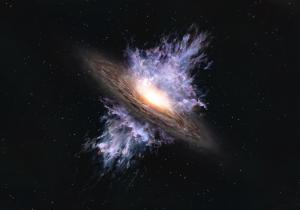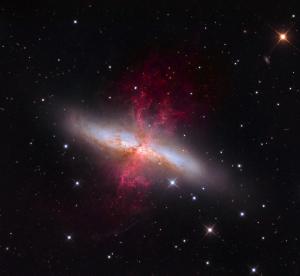Blog
Comes Now the Storm
21 June 2021
 ALMA (ESO/NAOJ/NRAO)
ALMA (ESO/NAOJ/NRAO)At the heart of most galaxies is a supermassive black hole. These beasts of gravity can play a crucial role in the formation and evolution of their galaxy. But astronomers still don’t fully understand when the influence of black holes becomes significant. Did large black holes form early in the universe, causing galaxies to form around them? Or did black holes grow after its primordial galaxy had begun to form? You might call this the chicken or egg problem. But a recent study suggests that galaxies and their supermassive black holes can have a mutual interaction that allows them to co-evolve.1
Galaxies can feed their black hole by amassing gas and dust in the central region. In turn, as the black hole consumes this matter, it can heat the material, which works to clear gas and dust from star-forming regions. One of the ways this occurs is through the production of a galactic wind. Just as the Sun’s intense heat creates a stream of ionized particles known as the solar wind, the intense heat of material near a black hole can create an ionized wind on a galactic scale.
 Adam Block/Mount Lemmon SkyCenter/University of Arizona
Adam Block/Mount Lemmon SkyCenter/University of ArizonaPrevious studies have shown that the galactic wind of a black hole is effective in clearing gas from the galaxy. This can dampen the growth of galaxies since the more gas a galaxy has in its central region, the more active the black hole and the more strongly gas is cleared. Astronomers have generally thought galactic winds form relatively late in the game, once a galaxy has entered an active period of star production, such as we see in starburst galaxies. But this latest work finds that galactic winds can form quite early in the life of a galaxy.
The work focuses on a galaxy known as J1243+0100. The galaxy is so distant that its light has traveled for 13.1 billion years. Using data from the Atacama Large Millimeter/submillimeter Array (ALMA), the team observed a flow of gas moving at 500 km/s from the galaxy. This is consistent with the flow of galactic winds in closer galaxies. The team was also able to measure the mass of the supermassive black hole, as well as the mass of its galaxy.
J1243+0100 is the youngest galaxy we’ve seen to have a galactic wind, and this suggests that active winds form early in the life of a galaxy. But perhaps more interesting is the comparison of the mass of the black hole with its galaxy. The study found that the mass ratio is roughly the same as the mass ratio of older galaxies, including that of the Milky Way. This strongly suggests a co-evolution of black holes and galaxies, such that the growth of one has a direct effect on the growth of the other. Thus, it might not be a matter of the chicken or the egg, but rather of siblings, roughly the same age, and shaped by their life together. This is just one example, so the team plans to observe several more young galaxies to see the co-evolution model is accurate.
Izumi, Takuma, et al. “Subaru High-z Exploration of Low-luminosity Quasars (SHELLQs). XIII. Large-scale Feedback and Star Formation in a Low-luminosity Quasar at z= 7.07 on the Local Black Hole to Host Mass Relation.” The Astrophysical Journal 914.1 (2021): 36. ↩︎